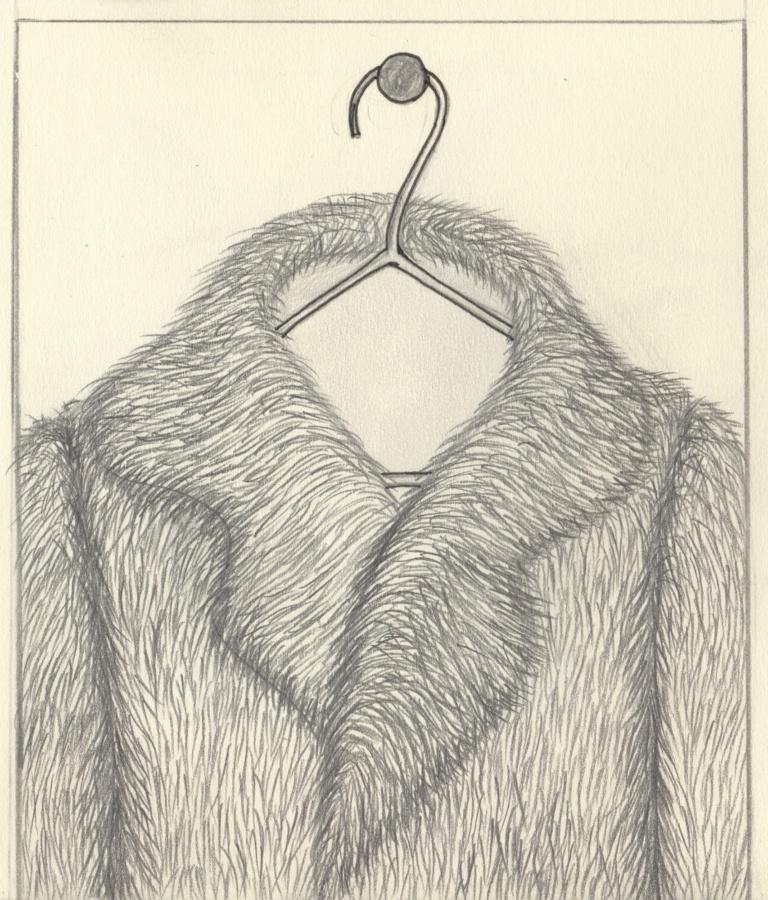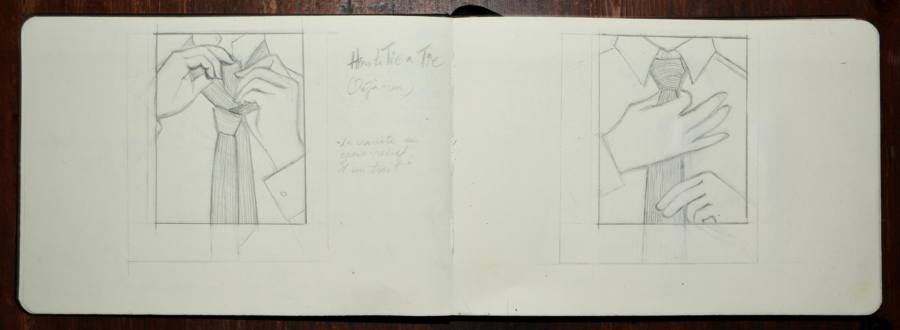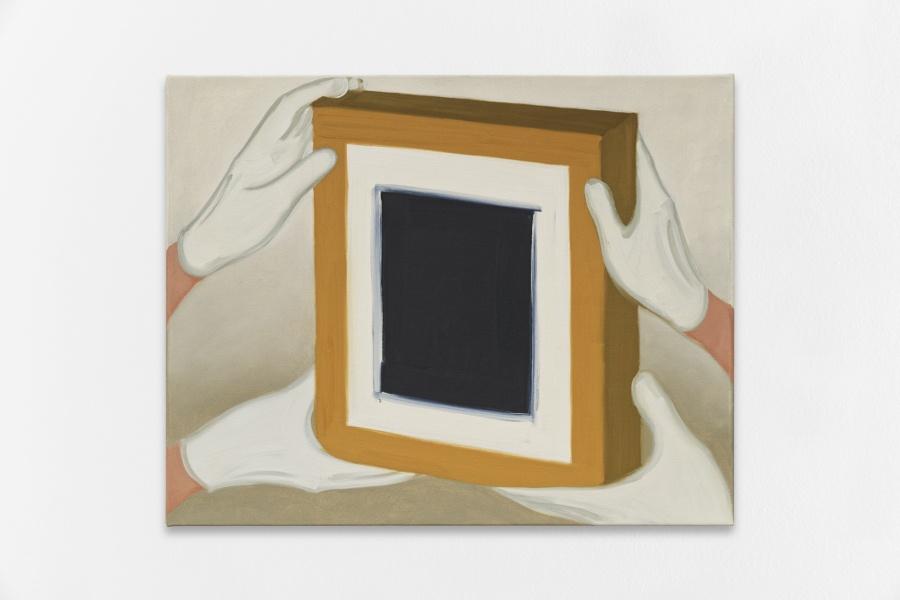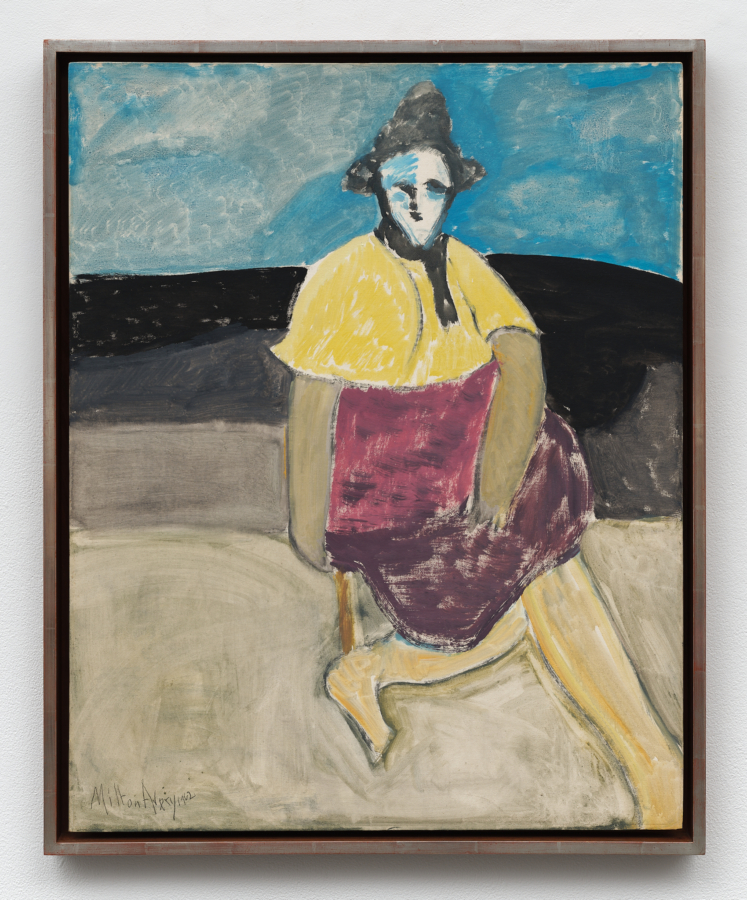September 9, 2020
Henni Alftan published by Karma, New York, 2020
Download as PDF
Henni Alftan is available here

Henni Alftan’s quiet paintings of quotidian presence—gold-rimmed glasses balanced on the bridge of a nose, tablecloths and skirts,a canoe on a glassy lake, the before-and-after of a cup of spilled milk—are less concerned with the present than they may at first seem, whether the present of the depicted scene or the present in which they were painted. We could venture instead that Alftan’s subject is both painting itself and the less materially tangible question of how images circulate as shards of human imagination, across time and place. A corollary query would be how such images are then deposited by artists, who thereby distort and perpetuate their multidirectional onward rush. Alftan lodges her work somewhere in the nexus of these questions concerning what we might call the persistence of images: an appellation I fuse from Salvador Dalí’s painting The Persistence of Memory (1931) and David Freedberg’s tome The Power of Images (1957). The former’s limpid timepieces suggest recollection’s instability and the coexistence of multiple temporalities, while the latter spurns the orthodoxies of aesthetics in favor of a psychology of human response to art. Both are apt in Alftan’s case, as is a more focused line of inquiry vis-à-vis the relationship of her images to, and their temporal and material transmission within, art’s Western history, though her work draws inspiration from sources far beyond it, too.
Abracadabra (2014) is a privileged work in this regard. In it, five disembodied fingers at each of the canvas’s top corners protrude from an inky black ground to pinch a white cloth held slack before us. At center, the cloth is sullied by a matrix of gently curved brush marks in chestnut brown which cohere into a roughly circular form, painted wet into wet with a wide brush. The result within this brushy patch is that some of the white paint from the cloth is pulled in streaks to the painting’s surface. As a representation of painted marks on cloth—which redoubles its ontological status as actual oil paint on canvas—Abracadabra nods to painting as a history of handmade objects constituted by authorial gestures. Indeed, Alftan’s insistence across her oeuvre on both oil paint and visible brushwork (see, for instance, Hands Behind His Back, 2019; Teeth, 2020; and Stumble (Déjà-vu), 2020) places her within this lineage in ways that both draw from and exceed it. But my chief interest in Abracadabra is the paradoxical way it repudiates this reading of painting qua painting while simultaneously advancing it.
Against its claim to the composed, authored image as painted by the artist’s hand, Abracadabra also lays claim to the legacy of the found image in its most extreme form. The painting alludes to the Veronica Veil, a cloth handed to Christ by a woman who took pity on him as he carried the burden of the cross on his way to Calvary. According to medieval legend, as Christ wiped sweat and blood from his brow, his true image, or vera icon, was miraculously impressed upon the cloth making it an acheiropoieton: an image not made by human hands. Paintings of the Veronica Veil, such as one by Francisco de Zurbarán (c. 1635–40) now in the Nationalmuseum in Stockholm, proliferated in the seventeenth century after the relic was installed in St. Peter’s Basilica in Rome.1 Indeed, such formal resonances abound in Alftan’s work. We can look to the tears of Northern Renaissance crucifixions (Sweat and Tears, 2017), or to Raphael (Holiday, 2016), Titian (Buffet, 2018), Hans Holbein (Goggles, 2017), Picasso, or Edward Hopper (Ajar [Déjà-vu], 2019), among others.
The task of tracing iconographic translations across time has long been the province of art historians such as Heinrich Wölfflin, Erwin Panofsky, George Kubler, Georges Didi-Huberman, and Aby Warburg, whose term Nachleben refers to an image’s persistence through time and the force of its living plasticity.2 Part of the success of Alftan’s work—which draws upon Pop and appropriation strategies of the 1960s and 1980s, as well as contemporary practices that critically reexamine modernism—lies in her ability to seamlessly fuse the found and the composed image.
What seems significant in Alftan’s work, however, is not its iconography as such—an allusion to the Veronica Veil, a billboard ad, or whatever else—but that her iconographic sampling conjures the philosophical, temporal, material, and conceptual concerns that have long occupied the discipline of art history in general (and, as this discussion begins to show, are especially tethered to the historic artworks Alftan references), and painting in particular. An inconclusive list of such concerns in Alftan’s case would include art’s capacity to plumb the limits of representation, to defer meaning, to probe the nonlinearity of time, to ask where images come from, and to express painting’s facility to point beyond its own history and objecthood. The artist is forthcoming about her interest in the threshold where recognition transforms paint into image, and image into meaning: “In painting one can see how a picture appears, for it is in our nature to see images in a simple stain or a few hasty brushstrokes. Our gaze seeks constantly to interpret, to give meaning to what it perceives. When is that moment, when begins or ends the resemblance?”3 After all, the Veronica Veil may be just as fictional as the lone authorial gesture. Yet taken together, these tropes ask us to contend with the theoretical limits of an image’s inception.
Indeed, Alftan has attended to the circulation of images for almost as long as she can remember. Upon announcing her intent to become a painter as a child in Helsinki, Alftan’s parents provided art books filled with masterworks and took her to visit the studio of Olli Lyytikäinen, a friend of her father, whose paintings hung in their home; now, based in Paris since 2001, she regularly haunts the Louvre.4 From this vantage, Alftan’s painting practice appears as a kind of non-hierarchical “making-with” the images she gathers from the world around her, akin to what Donna Haraway, in a different context, has called sympoiesis.5 The act of capturing a thing and holding it, distorted, fractured, or pure in our minds, is eminently relatable. Virginia Woolf described thusly this transfer from the materialism of external reality to the interior life of the perceiving subject:
Examine for a moment an ordinary mind on an ordinary day. The mind receives a myriad impressions—trivial, fantastic, evanescent, or engraved with the sharpness of steel. From all sides they come, an incessant shower of innumerable atoms; as they fall, as they shape themselves into the life of Monday or Tuesday, the accent falls differently from of old; the moment of importance came not here but there … Life is not a series of gig lamps symmetrically arranged; life is a luminous halo, a semi-transparent envelope surrounding us from the beginning of consciousness to the end.6

Henni Alftan’s notebook, 2019

Henni Alftan, The Auction, 2016, oil on canvas, 28 3⁄4 × 36 1⁄4 inches (73 × 92 cm)
Alftan’s process in the studio demonstrates this filtering of images through memory onto canvas. (To paraphrase one old chestnut: great artists don’t copy, they steal.) This form of mediating through the imprecision of memory puts her in the company of Anna Bjerger, Julie Curtiss, Esteban Ocampo-Giraldo, and Aglaé Bassens. With each step Alftan rethinks the image, resulting in further mediation. The work first takes physical form as a textual description that Alftan writes by hand in her notebook, itself based on the mental formulation of an image.7 In the same notebook, Alftan then sketches a blueprint for the painting, usually in pencil, and rarely in color. The drawings are precise and can involve a significant amount of erasure—as Alftan puts it, “I have no use for a vague sketch”—and if done in a single sitting, can be completed in half a day.8 Alftan then redraws the sketch onto the canvas in pencil
by hand, without the aid of a projector, so that the lines don’t smudge when painted over. Finished works do not have to exhibit a high degree of finish: visible traces of an underdrawing appear, for instance, along the outer contours of the gloved hands that hold up a blocky, Suprematist composition in The Auction (2015). Working one at a time, start to finish, Alftan applies oil paint to a cotton canvas prepared with a transparent acrylic primer. This model of transmission is presupposed not by mimesis but by the oscillation between resemblance and dissemblance. Through each phase of its life, the image finds its place between recognition and mystery.
In routing imagery through the capriciousness of personal memory, Alftan contradicts humanist- and Enlightenment-era certitude in the idealism of scientific truth in painting via linear perspective or the use of measuring and stabilizing tools such as grids and chin rests to aid in the accurate transcription of a sitter onto a support. Alftan’s paintings offer a resolutely shallow pictorial space that eschews the convention of painting as a “window onto the world” and blocks our ability to enter into them. Witness Peach (2019), for instance, or Dress the Part (2016). Even in paintings like The Limit (2014), Translucent II (2019), or Curtain (2020), which open onto a deeper expanse—often already partly obstructed by a barrier such as a fence or curtain—the distant view is blurred, nondescript, or cropped. Meanwhile, Alftan’s reflective surfaces, such as the knife blade in Kitchen (2016), turn the onlooker’s gaze back onto him- or herself, forging a reciprocity between her paintings’ multiple anchors in the past and the ever-shifting present in which we encounter them.
Rather than pulling the onlooker into illusionistic space, the paintings project into lived space. With painted tacking margins that extend the image on the canvas’s flat surface, the paintings are objects more than they are pictures. This formal and conceptual choice derived in part from Alftan’s training at the Villa Arson in Nice, where she experimented with the three-dimensionality of painted sculpture. In the context of the Villa Arson’s conceptual program—completed at a time in the early 2000s when few were willing to commit fully to the practice of painting—Alftan was doubly forced to justify her adherence to the medium. The works’ object status is further emphasized by the physicality of Alftan’s use of oil paint and, more recently, by her Déjà-vu series. A set of paired before-and-after images—like Disappeared (Déjà-vu) (2019), in which an upturned set of spectacle frames appears against two very different backdrops—the Déjà-vu paintings swing between semblance and dissemblance in a manner reminiscent of Pop art’s appropriation of advertisements that showcased the functionality of such consumer desirables as a cheery trash can, in Roy Lichtenstein’s case, or rhinoplasty in Andy Warhol’s. Intended to be shown simultaneously but in different rooms, Alftan’s Déjà-vu paintings are discrete objects reliant on the physical expanse of the gallery. They also turn the image back to the nebulous status of remembered image, carried by the viewer from one painting to its twin.
Disappeared (Déjà-vu) (2019), whose spectacles raise the question of visuality itself, returns us to the productive iconographic transfers in Alftan’s work and their attendant philosophical concerns. We might find, in the doorway’s lurking silhouetted figure, the harsh oblique lighting, the flat rectangular expanse at left, and the picture-rimmed interior space of Visitor (2016), an unlikely consonance with Diego Velázquez’s famed portrait Las Meninas (1656), itself a parable of inaccessible painted surfaces. As Michel Foucault pointed out in The Order of Things (1966), a number of Las Meninas’s constituent parts represent a point of reality outside the painting itself, thereby expressing a limit to the notion of painting as a self-contained world.9 And this seems to be precisely the point: through referencing images from (art’s) history, Alftan’s canvases destabilize unitary historical meaning, affording instead a maze of conflicting temporalities and identifications. Equally apropos of Alftan is that Foucault found in Velázquez’s work a critique of the supposed power of representation to confirm an objective visual order. Memory’s imprecision rebuffs objectivity; like Velázquez, Alftan shifts focus from the representation of meaning to the conditions of representation.



